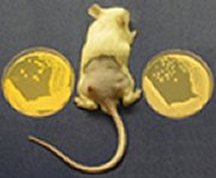Yellow color gives microbe its power
- More than 2 years ago
The bright-yellow pigment that tints the bacteria that cause staph infections is pivotal to the microbe’s virulence, a new study has found.

Staphylococcus aureus is the leading cause of infections acquired in hospitals and is fast becoming resistant to many antibiotics. Previous investigations of the microbe had suggested that its vivid color is due to carotenoids, the same antioxidant molecules that make carrots orange.
Antioxidants are widely considered beneficial to human health (SN: 5/7/05, p. 292: Long Live the Mammals: Antioxidant redirection extends mouse life span), but researchers haven’t known whether the molecules could benefit bacteria by making them more virulent, says George Liu of the University of California, San Diego.
Liu and his colleagues genetically engineered a strain of S. aureus to lack its characteristic yellow color. The researchers found that after they doused both normal and mutant lab colonies of the bacterium with oxidizing chemicals, such as hydrogen peroxide, the pigmented S. aureus was significantly more likely to survive.
The team also exposed several colonies of both strains to human neutrophils, immune system cells that kill bacteria by blasting them with oxidants. While all the mutant colonies quickly succumbed, many of the pigmented ones persevered.
When the researchers swabbed normal and unpigmented strains of S. aureus separately onto wounds on mice, the pigmented strain created lingering abscesses. In contrast, wounds swabbed with the unpigmented strains healed quickly.
Liu says that these results, published in the July 18 Journal of Experimental Medicine, suggest that S. aureus‘ yellow pigment is key to its ability to survive immune attacks. Drugs that could inhibit the bacterium’s production of carotenoids might weaken S. aureus and renew its susceptibility to various antibiotics, says Liu.